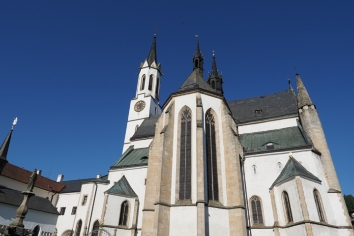
Conference ‘Music in Bohemia around 1400: Crossroads of traditions’
The members of the research project Old Myths, New Facts: Czech Lands in the Centre of 15th century Music Developments organized the international conference ‘Music in Bohemia around 1400: Crossroads of traditions’ which took place on 21st-22nd November 2019 at Vila Lanna, Prague.
The musical culture of the Czech Lands before 1420 is characterized by a formidable variety of genres, musical forms, and sources of inspiration. Manuscript no. 42 from the library of the Cistercian Abbey of Vyšší Brod provides a unique insight into this musical environment. Its repertoire exemplifies the seminal role of late medieval chant as well as the beginnings of trends fully developed later in the 15th century. The presented papers focused on phenomena for which manuscript no. 42 is the earliest and unsubstitutable source: song traditions and late medieval chant. Both musical worlds adopted a fashion of rhythmizing monophonic melodies – cantus fractus – and setting to polyphony which presented new challenges for the local composers. All contributions asked the question of transfers of musical repertoire within the Central European cultural space.
The conference was opened by Hana Vlhová-Wörner and Jan Ciglbauer and their introducing papers to the late chant and song traditions in Bohemia around 1400, respectively. There were mostly hymnological contributions in the programme: Benedicamus tropes (Konstantin Voigt, Stefan Rosmer) and encounters of Latin and German traditions (Gisela Kornrumpf, Ute Evers). The second focus point was the phenomenon of cantus fractus from different perspectives (Bernhold Schmid, Lenka Hlávková). The presentation by Franz Körndle showed how challenging the introduction of musical instruments was for authors in the practice of the 15th century, especially the treatment of rhythm. To complete the picture of Bohemian tradition around 1400, Charles Brewer presented the tradition of the motet Veni sancte Spiritus – Da gaudiorum – Veni sancte and Rhianydd Hallas some aspects of the Visitation office by John of Jenstein.
The end of the first day was devoted to two sections with live music. In "Unboxing VB 42", the ensemble Gontrassek and Jan Baťa performed the most important monophonic repertoire from VB 42, such as late-medieval chant with rhythmized sections and strophic songs. The second live section with Ostravská bandaska and Viktor Velek presented 19th and early 20th century artistic reflections on Bohemian music around 1400. The ensemble is the product of a unique collaboration between the teachers and students of the University of Ostrava and specializes in the “second life” of Czech traditions, most notably of John Hus and Hussitism.



